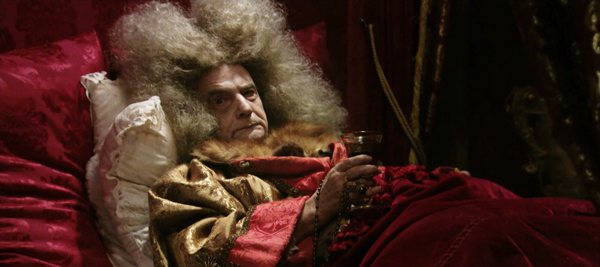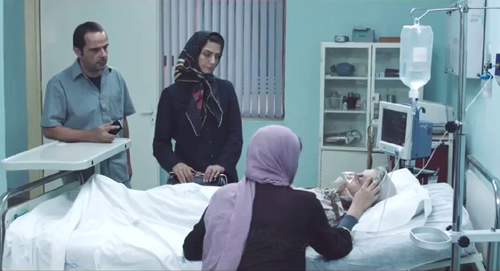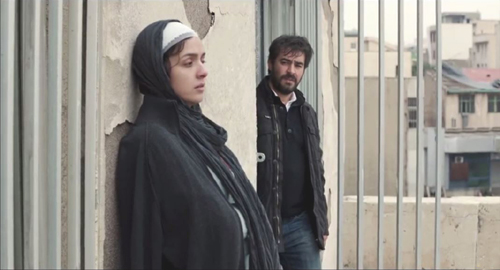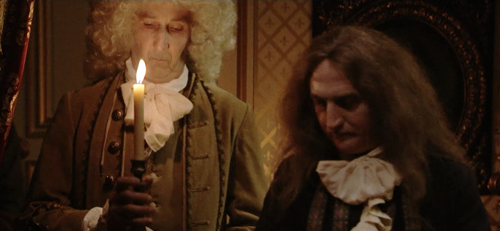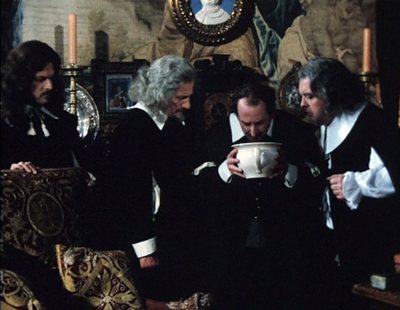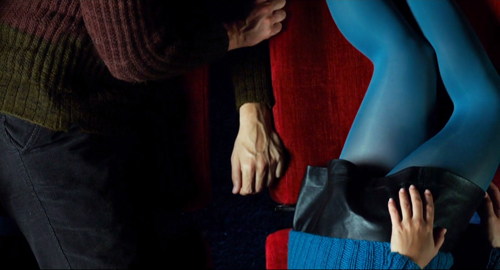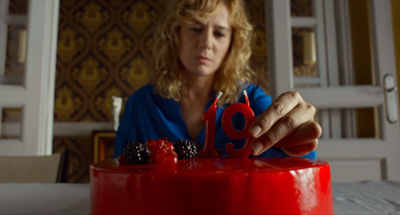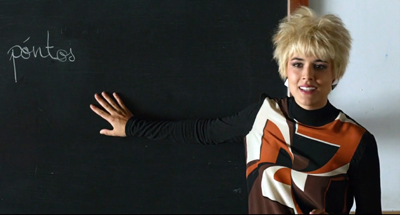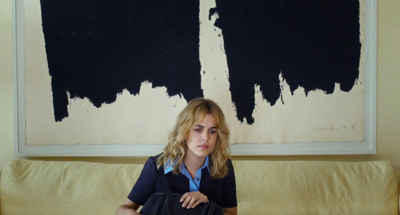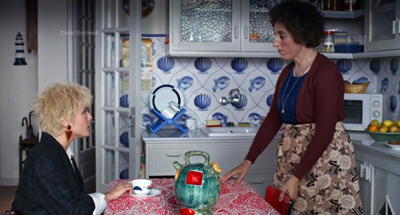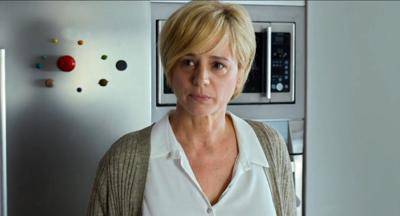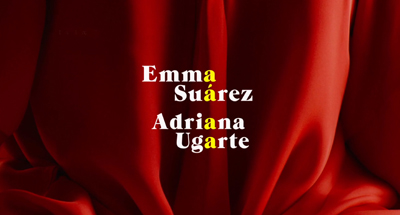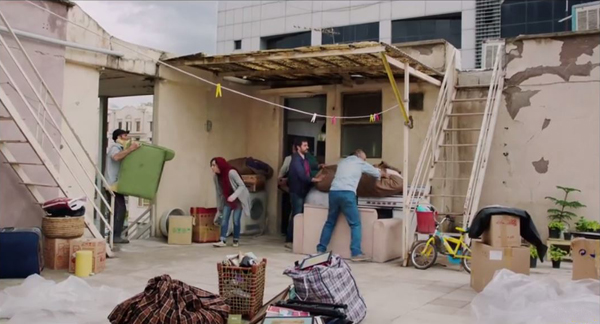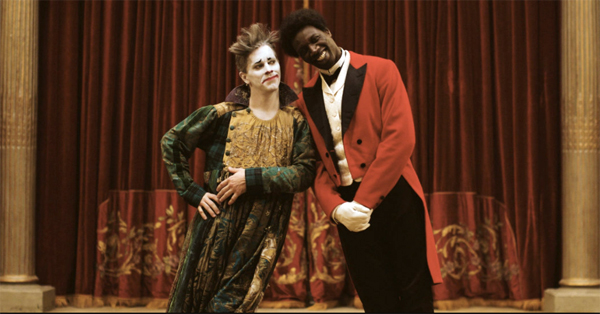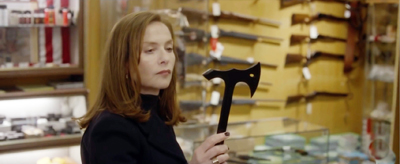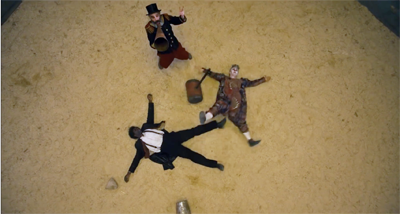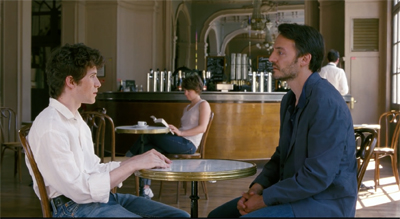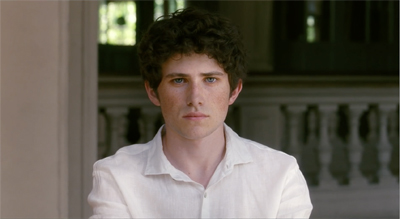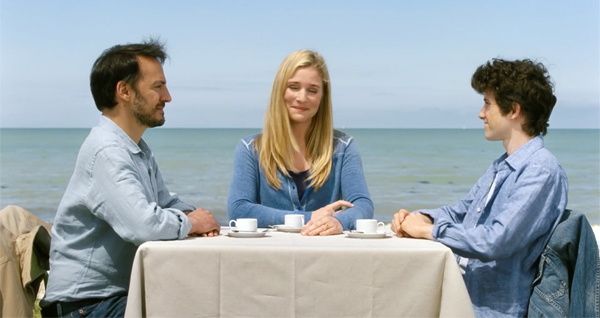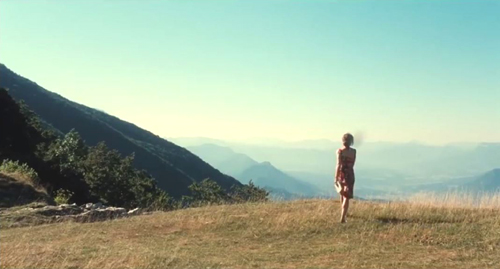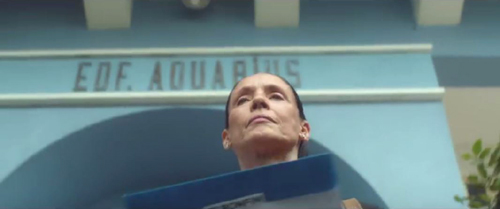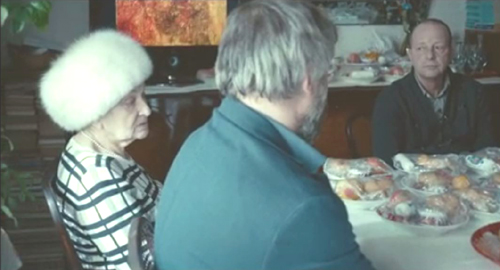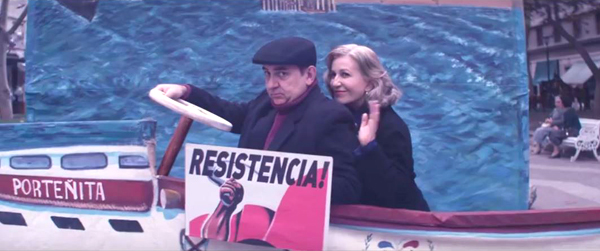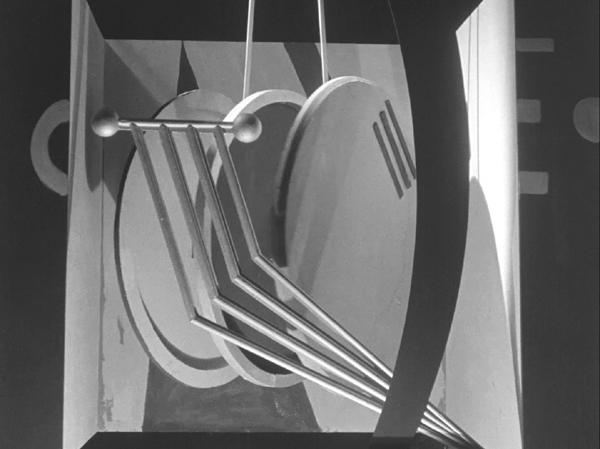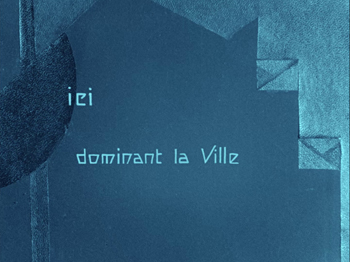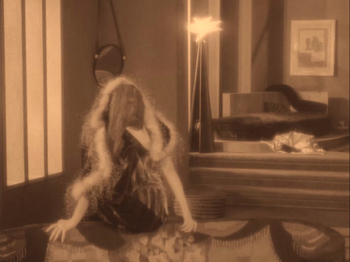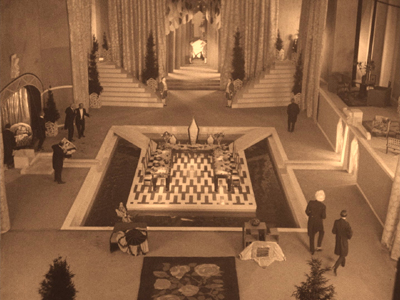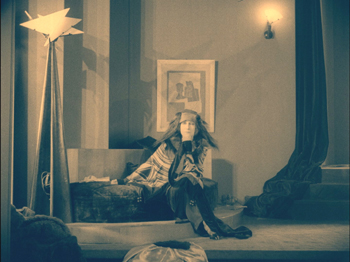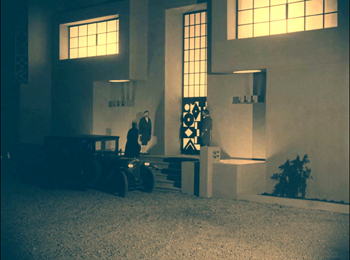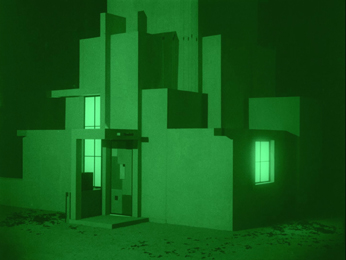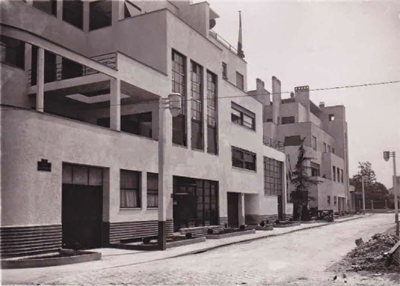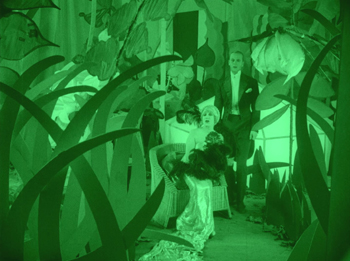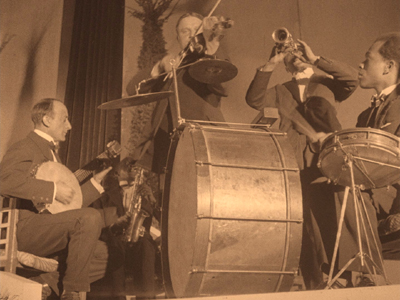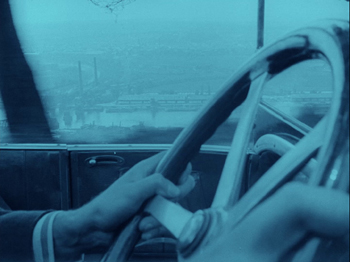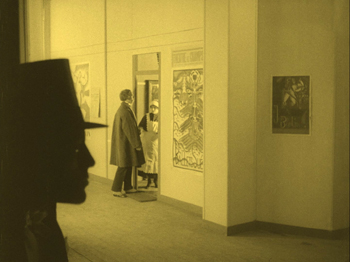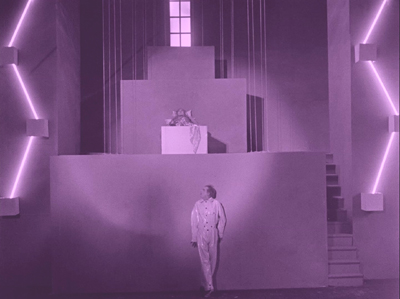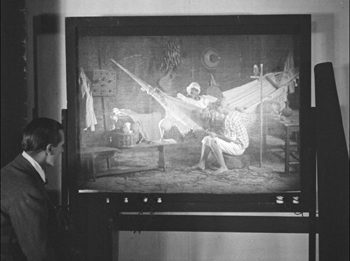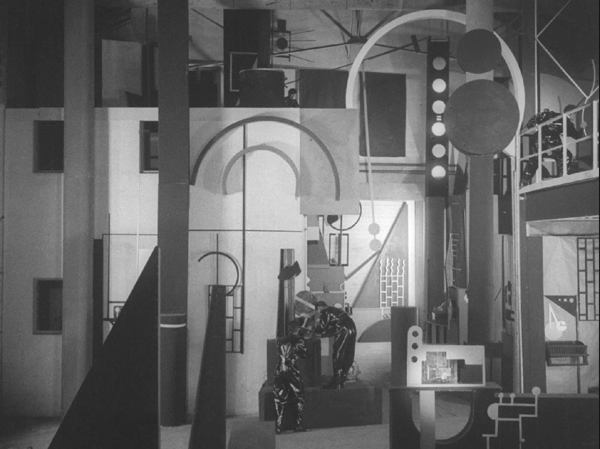Archive for the 'National cinemas: France' Category
More from VIFF 2016
The Death of Louis XIV (Albert Serra, 2016).
The Vancouver International Film Festival ended yesterday, but the films and the pleasures they yielded linger on. Our first two entries are by Kristin, the last two by David.
Smog over Tehran
Iranian film and television director Behnam Behzadi is not well-known outside his native country. Inversion, which was shown in the Un Certain Regard section of Cannes this year, suggests that he deserves to have more international exposure for his work.
The title refers to the meteorological phenomenon that can cause dense pollution to form at ground level. The film opens with shots of Tehran streets seen dimly through a thick haze. The pollution has a causal role to play, since the heroine’s elderly mother ends up in a hospital as a result of breathing problems. More metaphorically, however, the title refers to a sudden reversal in Niloofar’s situation.
Initially she seems to be in a relatively strong position for a Iranian woman. Still unmarried in her 30s, she runs a small, prosperous garments factory and begins to date an amiable man whom she clearly likes. Her mother’s sudden health crisis, however, leads a doctor to insist that she be moved to the healthier northern part of the country, where Niloofar’s sister and brother-in-law happen to own a small villa. Niloofar, with no spouse or children, is pushed by the couple and her brother into agreeing to go along and take care of her mother. She hopes to keep the factory going, but the brother selfishly rents out the premises to pay off his own debts. Niloofar resists going with her mother, but as her siblings ignore her wishes and she discovers that the man she may be considering marrying has kept an unpleasant secret from her, she realizes how little power she has over her own life.
As in Farhadi’s films, a seemingly ordinary situation suddenly deteriorates from a simple cause. But Farhadi tends to gain complexity by avoiding making his characters into villains. In his films, as in Renoir’s, “everyone has his reasons.” In Inversion, however, the brother is straightforwardly in the wrong, refusing to consider Niloofar’s desires and even threatening her with violence during one argument. Overall the film is entertaining, with Niloofar an engaging figure who gives an insight into the situation of women in contemporary Iran.
Mistakes were made
Asghar Farhadi is best known for A Separation (2011), the first Iranian film to win an Oscar for best foreign-language film. His earlier masterpieces, About Elly (2009) and my own favorite, Fireworks Wednesday (2006), are slowly coming to be known in the West, largely via home video. After the slightly disappointing The Past (2013), Farhadi is back on track with The Salesman.
The film opens with a tense, dramatic scene in which a Tehran apartment building threatens to collapse and its inhabitants frantically struggle to evacuate. The result is that the central characters, Emad and his wife Rana, must quickly find a temporary apartment (see bottom) while they also prepare to star in a production of Arthur Miller’s Death of a Salesman.
They seem to be coping until Rana mistakenly opens the door of their new apartment, assuming that her husband has come home. The shot holds on the door, standing ajar, as Rana moves off to take a shower and the scene ends. Later we learn that an unknown assailant has entered the apartment. Whether he raped Rana or simply startled her so that she fell and cut herself on broken glass is never revealed, but she is traumatized and unable to proceed, either with her everyday life or her role as Linda Loman in the play. Emad tries to be supportive, but he becomes obsessed with tracking down the intruder.
The mystery gradually unravels as the shady background of the apartment’s former tenant emerges, and revelation of the identity of the intruder undermines the question of revenge. As in Farhadi’s other films, characters’ mistakes, honest or otherwise, compound each other. Ultimately, absolute blame is hard to assign.
The Salesman won two prizes at Cannes: best screenplay for Farhadi and best actor for Shahab Hosseini as Emad. Amazon Studios and Cohen Media will release it in the US on 9 December.
The King is (nearly) dead
Early on in Roberto Rossellini’s Taking of Power by Louis XIV (1966), we find Cardinal Mazarin on his deathbed. Mazarin’s doctors decide to bleed him; a priest advises him on the disposal of his wealth; finance minister Colbert briefs him on intrigues at the king’s court. The shots are lengthy, following the men around the chamber.
This remarkably deliberate sequence was considered quite striking at the time. In a story centered on Louis XIV, Rossellini devotes thirteen minutes to Mazarin. His impending death creates exposition about the ensuing power struggles and initiates a somber pace rather different from that of the standard historical film. The scene also reminds us that historical events have a tangibly material side, as when doctors confer gravely over the stools in His Eminence’s chamber pot.
Rossellini, who’s interested in the tactics by which Louis tames the nobility, doesn’t show us the King’s final hours. That morbid task is taken up by Albert Serra’s The Death of Louis XIV. Unlike Rossellini’s film, which is filmed in radiant high-key and shows sumptuous detail of fabrics and flooring, Serra’s treatment relies on chiaroscuro, with shadow areas broken by trembling candlelight. And while Rossellini’s PanCinor lens swivels and zooms around these apartments, Serra cuts among close views of faces, hands, and a steadily blackening gangrenous royal foot.
In the process Serra expands the physicality of the Mazarin sequence to the length of an entire film. Louis seems to linger for days, but we’re given no distinct sense of how much time passes; in only two shots do we glimpse the outdoors, in bleary light that might be dawn, drab afternoon, or dusk. The time is filled out by court rituals, such as the King’s doffing his hat to his entourage, and by the steady decline of his powers. He can’t swallow food and can barely take water or wine. Through it all, Louis feebly issues his final orders about matters of state and the disposition of his body. A long scene of the last rites is punctuated by a barely discernible fart. This is a movie centrally about a degenerating body.
Even more than Rossellini did, Serra probes the shaky state of medical science of the time. (Louis died in 1715, just as the Enlightenment was beginning.) When Louis’s leg contracts gangrene, the learned doctors debate whether to amputate it. A quack shows up with an elixir made of bull sperm and other recherché ingredients. At the end, the principal physician takes the blame for the king’s death and makes a remarkable apology directly to the camera. Before that, though, Serra has given us a three-minute shot of His Highness reproachfully staring at us (up top) while we hear a Kyrie Eleison somewhere offscreen. Another echo of film history: Louis is played by Jean-Pierre Léaud, who looked out apprehensively at us many years ago, in the seashore ending of The 400 Blows. It’s glib to say that cinema films death at work, but here the cliché gains some meaning.
Master of the weepie
Is any filmmaker more unfairly taken for granted than Pedro Almodóvar? For over thirty years, he has created sparkling, handsome entertainments that combine cinematic intelligence with outrageous eroticism and insidious emotional punch. His films revel in plot complications and edgy humor. Along the way he effortlessly deploys the techniques that make modern cinema modern, from flashbacks and voice-overs to subjective sequences and abrupt replays that fill in gaps.
He makes it all look easy, and gorgeous. After the drab grays and browns of Hollywood fare, what a pleasure to see a film packed with saturated primaries and bold designs. He proves that you can go as dark as you like in plotting and still make things look delightful.
His characters are clothes horses, I grant you, but not the least of his debts to Old Hollywood is the belief that we want to see presentable people in pretty costumes and settings. The world is ugly enough, he seems to say; why add to it? Seeing The Girl on the Train reminded me how glum American movies are determined to look. An Almodóvar apple looks good enough to eat, and a housekeeper’s roseate apron seems the height of chic. In this world, even refrigerator magnets evoke a Calder mobile.
These elegantly voluptuous tales make unabashed appeal to Hollywood genres: the screwball comedy (Women on the Verge of a Nervous Breakdown, I’m So Excited), the illicit romance (Law of Desire, The Flower of My Secret), the twisty thriller (Live Flesh, The Skin I Live In), even the ghost story (Volver), and above all the melodrama—medical (Talk to Her) and maternal (High Heels, All about My Mother). He rolls Lubitsch, Sirk, and Siodmak into a nifty package, tied up with a ribbon bow of pansexuality.
 Julieta (from which all my images come) revisits the maternal melodrama, specifically the mother-daughter nexus. Our heroine, beginning as a spiky-haired classics teacher, seems to have an idyllic life married to a fisherman, but soon infidelity, misunderstandings, and a tempestuous storm shatter it. All the paraphernalia of melodrama—raging seas, unhappy coincidences, ingratitude, and dark secrets—threaten Julieta’s efforts to save her marriage and protect her daughter. Told in flashbacks, chiefly through a letter she writes her daughter Antia, the two major phases of Julieta’s life get intercut in surprising and gratifying ways. With his usual cleverness, Almódovar has Julieta played by two female performers, with a surprise match-on-action linking them in one scene. A beautiful purple towel helps, as the poster sneakily suggests.
Julieta (from which all my images come) revisits the maternal melodrama, specifically the mother-daughter nexus. Our heroine, beginning as a spiky-haired classics teacher, seems to have an idyllic life married to a fisherman, but soon infidelity, misunderstandings, and a tempestuous storm shatter it. All the paraphernalia of melodrama—raging seas, unhappy coincidences, ingratitude, and dark secrets—threaten Julieta’s efforts to save her marriage and protect her daughter. Told in flashbacks, chiefly through a letter she writes her daughter Antia, the two major phases of Julieta’s life get intercut in surprising and gratifying ways. With his usual cleverness, Almódovar has Julieta played by two female performers, with a surprise match-on-action linking them in one scene. A beautiful purple towel helps, as the poster sneakily suggests.
It’s all about guilt, passed from husband to wife and mistress and then to daughter and even daughter’s pal, with the obligatory recriminations and tearful confessions. The plot is continually surprising, yet every scene snicks into place. Neat parallels among couples develop quietly, and tiny hints planted in the beginning pay off. As usual with Almodóvar, the opening credits guarantee that you’re in assured hands. They also tease us with motifs. Here the film’s dual structure (two phases of life, two actresses) is suggested through lemon-yellow letters sliding into alignment.
The two women on my left started crying halfway through the movie. I tell you, this director is a credit to the species.
Special thanks to Michael Barker and Greg Compton of Sony Pictures Classics. Sony will release Julieta in the US on 21 December.
We have earlier entries on Farhadi’s About Elly, on A Separation, and on The Past. We discuss Serra’s ingratiating Birdsong here, and Almodóvar’s cunning The Skin I Live In here.
The Salesman.
Long live French cinema at VIFF: A guest post by Kelley Conway
Chocolat (2016).
Kelley Conway, one of our colleagues here at UW–Madison, is an expert on French film; we talked about her latest book, a study of Agnès Varda, here. We invited her to contribute to our blog, and here’s the result.
David and Kristin introduced me to the pleasures of Vancouver and its superb festival, VIFF. Hats off to Alan Franey and the other programmers who created a strong and varied lineup of films. I saw excellent works from Romania (Sieranevada), Poland (The Last Family), Canada (Maliglutit), and Iran (The Salesman), but here I will address some of the strongest selections from France.
Shopping till she drops
Now and then, the French make films that marry the conventions of art cinema and popular genres. François Ozon’s postmodern pastiche 8 Women evokes both the musical and the thriller. Claire Denis’s art-horror hybrid Trouble Every Day is contemplative and painterly, but also bloody and scary. Olivier Assayas continues the tradition by combining the traits of art cinema and Gothic horror in Personal Shopper, his second film featuring Kristen Stewart as a loyal assistant to a famous woman. While The Clouds of Sils Maria (2014) turns on the intense, shifting relationship between Stewart and an aging theater actress (Juliette Binoche), Personal Shopper is about a grieving young woman with little emotional connection to her celebrity boss (Nora von Waldstätten).
By day, Maureen (Stewart) makes the rounds of Chanel and Cartier, shopping for her employer; by night, she attempts to communicate with her recently departed twin, Lewis. The film’s links to the Gothic are established early on, when Maureen spends the night in a big, drafty house, awaiting a sign from her brother. Shutters bang, wind blows, and spectral figures attack. The supernatural is juxtaposed with the everyday; like so many twentysomethings, Maureen works in a job she hates in order to pay her rent.
Interestingly, she’s really good at this job. Wearing jeans and sneakers, she strides into exclusive boutiques, expertly chooses belts, bags, and baubles worth thousands, and transports them across Paris, skillfully navigating traffic on her scooter. At one point, she makes a quick trip to London to pick up a few dresses. Maureen tracks her employer’s movements via celebrity journalism on the internet and notes with satisfaction when the fashion maven wears the items she has chosen. But this is as close as Maureen gets to the rarefied world of high fashion; she is explicitly forbidden from trying on the beautiful things she covets. When she eventually breaks this rule, she must contend with the consequences.
Personal Shopper divided critics; the film’s Cannes premiere apparently elicited both hisses and a standing ovation. Stewart’s tendency to mumble here can indeed irritate. But the film’s conclusion offers a satisfying mix of suspenseful communication with the dead and art-house ambiguity.
Rape, violent videogames, and other breaches of Parisian decorum
Like Personal Shopper, Elle (Paul Verhoeven) plays with genre conventions. The film opens with a black screen and the offscreen sounds of moaning that could signify pleasure or pain. It’s pain, as it turns out: Michèle (Isabelle Huppert) is being raped on her living room floor by a masked intruder. Later, she calmly cleans up broken glass and soaks in the bathtub. When a circle of blood emerges from between her legs, staining the bubbles, she sweeps it away. She tells her close friends about the rape, invests in pepper spray and an ax, and takes a shooting lesson.
Are we in for a rape-revenge film? Or perhaps a poignant drama about a woman who finds the strength to rebuild her life after a traumatic event? Not exactly. The film references rape revenge and melodrama, only to veer away from these traditions toward an uneasy pairing of satiric comedy and thriller. The film is filled with events typical of a French film about middle aged Parisians in a bourgeois milieu: well dressed people get together for dinner in excellent restaurants, the successful completion of a project at work is celebrated with an elegant party; Michèle loses her mother to a stroke, but gains a grandchild.
But Michèle also runs a company that makes violent and misogynistic video games, is hated by her employees, and mocks her admittedly ridiculous mother and son in public. The film’s revelation of a traumatic event in Michèle’s childhood might have been used to motivate her cynicism, but traditional narrative causality is not on here. Peoples’ reactions to events in Elle are always somehow “off.” The film’s upbeat conclusion is particularly confounding: key characters appear to have changed for the better, but we don’t know why.
Is the film an allegorical treatment of the toxic relationships between men and women? Perhaps. Michèle exhibits behavior often attributed to men. In a reversal of Laura Mulvey’s classic analysis of voyeurism, she spies on a neighbor she finds attractive, holding binoculars in one hand and masturbating with the other. She mechanically performs sexual acts without even pretending to be interested in her partner. She sexually humiliates an employee and sleeps with a friend’s husband because she “felt like getting laid.”
Elle hangs tenuously by its manicured fingernails to European art cinema. The film was directed by Dutch filmmaker Paul Verhoeven, better known for his Hollywood films Robocop (1987), Total Recall (1990), and Basic Instinct (1992) than for his work in Europe. Elle is a hybrid of Tie Me Up, Tie Me Down (1989) and The Piano Teacher (2001), borrowing Almodovar’s rape victim fascinated with her rapist and Haneke’s masochistic ice queen, also played by Huppert. Elle will intrigue and amuse some viewers and disgust others.
The film has been submitted to the Academy as France’s entry for Best Foreign Film. Huppert herself has never been nominated for an Oscar and she certainly deserved a “best actress” award for any number of the films she has made with Godard, Chabrol, Haneke, and Denis. This may be her year: her intriguing cipher in Elle and her subtle performance as a philosophy teacher in Mia Hansen-Løve’s Things to Come (2016), also playing at VIFF, both merit recognition.
Race under the big top
French superstar Omar Sy stars in Chocolat (released as Monsieur Chocolat), a Gaumont biopic about Rafael Padilla. Padilla was an Afro-Cuban who escaped abject poverty to become a famous clown in Belle Époque Paris. The film recounts the early period of Padilla’s career in a provincial circus, where he masquerades as a cannibal. The clown George Footit, played by James Thierrée (a grandson of Charlie Chaplin), sees his potential and they form a duo. Discovered by impresario Joseph Oller, they become “Footit and Chocolat,” and perform nightly at the Nouveau Cirque in Paris.
The film’s rags-to-riches tale condenses and alters the multiple phases of Padilla’s career; he actually enjoyed solo success in Paris before he met Footit. Still, the film succeeds at revealing the clown’s comic talent and physical grace. Padilla is initially naïve and good-natured, like the auguste clown character he plays in his act with Footit, but his rage grows at having to play the perpetual fool. He abandons the act and tries to mount a career in the theater playing Othello, but ends up back in a provincial circus, broke and sick.
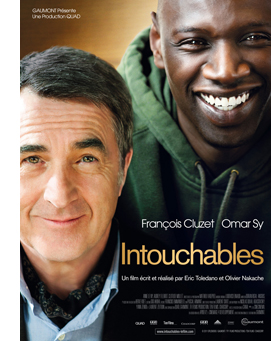 At first glance, the plot of Chocolat resembles that of Zouzou (Marc Allégret, 1934), another all-too-rare French film featuring a black protagonist. In Zouzou, Josephine Baker plays a laundress who becomes queen of the music-hall, but loses the man she loves (Jean Gabin) to her blonde best friend. Chocolat is more self-conscious about its racial politics and, in a way, can be seen as a riposte to the controversy around Sy’s earlier hit, Intouchables (Olivier Nakache and Eric Toledano, 2011). In Intouchables, a wealthy, white, disabled man (François Cluzet) hires as his aid a young, black man (Sy) from the banlieue; friendship, humor, and mutual respect ensue. Intouchables was phenomenally successful at the box office, nearly overtaking the top-grossing French film of all time, Bienvenue chez les Ch’tis (2008). But it had a complicated critical reception. (See the codicil.)
At first glance, the plot of Chocolat resembles that of Zouzou (Marc Allégret, 1934), another all-too-rare French film featuring a black protagonist. In Zouzou, Josephine Baker plays a laundress who becomes queen of the music-hall, but loses the man she loves (Jean Gabin) to her blonde best friend. Chocolat is more self-conscious about its racial politics and, in a way, can be seen as a riposte to the controversy around Sy’s earlier hit, Intouchables (Olivier Nakache and Eric Toledano, 2011). In Intouchables, a wealthy, white, disabled man (François Cluzet) hires as his aid a young, black man (Sy) from the banlieue; friendship, humor, and mutual respect ensue. Intouchables was phenomenally successful at the box office, nearly overtaking the top-grossing French film of all time, Bienvenue chez les Ch’tis (2008). But it had a complicated critical reception. (See the codicil.)
Mainstream French critics saw Intouchables as a fun buddy film, but others denigrated the film for its “televisual” look and its simplistic class politics. But after a Variety critic denounced the film for its “Uncle Tom-ism,” the French rallied around the film, presenting a more unified stance in favor of Intouchables as a welcome step in the move toward racial equality on the screen. Chocolat, for its part, underscores more overtly the racism Padilla experiences. The plot invents an episode in which he is arrested and tortured for not having his identity papers, and it shows his mortification at the sight of Africans performing their exoticism for the pleasure of Parisians at the Colonial Exhibition. Chocolat is well worth seeing for its lively portrait of Belle Époque popular entertainment and for its role in the ongoing debates about French cinema’s representation of race and its place in the blockbuster economy.
Simple, strongest
The Son of Joseph might be the only comedy made this year that pays homage to Bresson, Caravaggio, and the nativity story. In this austere yet witty film, brooding teenager Vincent (Victor Ezenfis) seeks the identity of his father. His single mother Marie (Natacha Régnier), a compassionate nurse, has kept this knowledge from him, and with good reason. Oscar (Mathieu Almaric) is a philandering and pretentious publisher who cannot even remember the names of his three legitimate children, much less acknowledge Vincent.
At a book launch party (in which Parisian intellectual pretension is deliciously skewered), Vincent spies on Oscar. Later, Vincent is hiding under a divan when the louche publisher beds his secretary. Vincent eventually finds a surrogate father in Oscar’s kindly brother Joseph, played by a Fabrizio Rongione, a favorite of Eugène Green and co-producers Jean-Pierre and Luc Dardenne. Like many of the adolescents in the Dardenne universe, Vincent is an angry kid: he shoplifts, watches as other boys prepare to torture a caged rat, and shuts out his mother. But he returns the tool he stole, rejects animal abuse, and reconnects with his mother.
American-born French director Eugène Green, director of La Sapienza (2014) and The Portuguese Nun (2009), brings to The Son of Joseph his characteristic compositional precision, an appreciation for Baroque art and music, and a distinctive way of filming conversations.
Green is clearly not interested in standard psychological realism or the mumbling delivery and the improvisation we see in some American indie films. Instead, he strives for the understated and precise acting we see in the work of Bresson or Akerman. Green’s actors deliver dialogue, whether arch or sincere, with perfect diction, often while looking directly into the camera. Green also opts for sparse, often symmetrical, compositions, and he usually dispenses with camera movement. Each shot renders the character’s line of dialogue in toto. “Simple things are, for me, strongest,” he said in 2015.
The static shots and direct address are never boring. One never tires of Green’s actors and Paris looks stunning here. Interiors are sparsely decorated and beautifully lit; exteriors typically consist of characters strolling through the Palais Royale or the Luxembourg Gardens. Moreover, Green insists upon the power of art: Caravaggio’s Sacrifice of Isaac and Georges de la Tour’s Joseph the Carpenter figure prominently here, as does an extraordinary singing performance in a church.
The film’s rigorous design does not prevent it from exuding hope and a touching sincerity. The concluding scene on the beach in Normandy retains the film’s minimalist design and rewards viewers who remember Au hasard, Balthazar, but also suggests the formation of a new family and the redeeming power of love.
Upcoming U.S. releases: Sony Pictures Classics has slated Elle for 11 November. Kino Lorber will release The Son of Joseph on 12 January, while Personal Shopper (IFC Films) is scheduled for 10 March. Chocolat does not yet have a U.S. distributor.
Charlie Michael traces the critical response to Intouchables in “Interpreting Intouchables: Competing Transnationalisms in Contemporary French Cinema,” SubStance 133, Vol. 43, no. 1 (2014), 123-137.
Eugène Green’s remarks about simple things comes from his Film Comment interview on La Sapienza. David has written entries on Green’s compass-point editing here and here.
The Son of Joseph (Eugène Green, 2016).
Refutations of the death of cinema, courtesy the VIFF
Maliglutit (Searchers)
Kristin here:
About three weeks ago David pointed out that the “death of cinema” being bewailed by many critics and pundits was based largely on the disappointments of the summer of Hollywood blockbusters. Taking a larger perspective, the cinema looks to be thriving. Herewith some further evidence as we continue to enjoy the rich schedule of screenings at the Vancouver International Film Festival. Some of these films are good, some very good, some perhaps great and destined to be watched for decades to come.
Maliglutit (Searchers)
In 2001 the first Inuit-made feature film, Atanarjuat: The Fast Runner won the Golden Camera at Cannes. Admirers of it, among whom we count ourselves, have wondered whether there would ever be a follow-up. Since Antanarjuat, director Zacharias Kunuk has had an active career in documentaries. Now, however, he has returned with a second fiction feature, Maliglutit (Searchers).
The title proclaims the film’s inspiration: John Ford’s The Searchers. Kunuk wanted to make a western, but one “made entirely the Inuit way.”
From the start, I resolved to anchor the production in my home community of Igloolik. It was important to get the faces right. I brought on Natar Ungalaaq, who played the lead in “Atanarjuat – The Fast Runner,” as co‐director to work with the actors preparing their performances and to mentor a new generation of Inuit filmmakers. Our cast and crew included regular collaborators, but also a number of new people in training.
Igloolik is a small island in the Northwestern Passages, far to the north in Canada. It’s population is about 2000. An extraordinary place for such important films to come from.
Maliglutit can hardly be said to be a remake of Ford’s film. Its borrowing from The Searchers is solely the kidnap plot. The hero is Kuanana, whose wife and daughter are carried off on dogsleds by four members of a neighboring tribe, led by Kupak. Kuanana and his son give chase. Unlike in The Searchers, there is no conflict between the older and younger men. Unlike Ethan Edwards, who is revealed to be hunting down the tribe who kidnapped Debbie in order to perform a sort of honor-killing, Kuanana simply wants the women back. The psychological complexities of The Searchers are replaced by a focus on the details of Inuit life in 1913 (an era in which firearms were starting to replace traditional weapons, above) and the frightening beauty of the bleak late-winter landscapes through which the chase progresses. The two women resist and seek to escape during the entire chase, and they play an active role in the climactic rescue.
Although virtually all of the crew were also local Inuits, producer and cinematographer Jonathan Frantz, was a crucial figure. He created epic images of the harsh, snowy landscapes during the chase (see top), often shot in the early morning light of March.
Maliglutit seems to have no distributor. Watch for it in other festivals and eventually on home video–though the scale of the compositions really demands a big, big screen.
From a textbook to an upheaval
If women directors are still struggling to establish themselves in Hollywood, they are much in evidence here at Vancouver. Films from a wide variety of countries were helmed by women, including Mia Hansen-Løve (or Mia Hansen Love as she is billed here), who won the Silver Bear award for best director at the Berlin International Film Festival and the Bucharest International Film Festival. (See here for an interview with the director shortly after the Berlin premiere.)
Her Things to Come (L’avenir) well demonstrates her mastery of traditional, skillful filmmaking. Her camera is locked down rather than restlessly roaming, with simple reframes to follow actors’ movements. The compositions are impeccable, the editing clearly planned in advance, and the story told in an unobtrusive, clear fashion.
I found the film appealing partly because it presents that rare thing, a plausible depiction of the life of an academic. The heroine, Nathalie, played in another star turn by Isabelle Huppert, teaches philosophy in a Parisian high school. Her students are obviously sophisticated kids, and she finds fulfillment in her work. Her husband is an intellectual, and they have two children. Her life seems ideal and her future certain. In the course of the film, however, she suffers a series of setbacks.
Amusingly, these are initially signaled by a meeting with editors at the publishing house that has brought out her textbook and will be publishing a collection of essays aimed at classroom use. The editors cheerfully show her some garish designs intended to boost sales. Her husband announces that he’s leaving her for another woman, her mother needs to be institutionalized, and she loses her job.
The future is suddenly turned upside down, and the film depicts Nathalie’s efforts to maintain her usual cool, in-control demeanor while seeking a new path in life. Although the film is quite sympathetic to her, there is considerable humor as well. Entertaining, thought-provoking, and visually lovely.
The aging of Aquarius
I was very impressed by Kleber Mendonça Filho’s Neighboring Sounds, shown at the 2012 VIFF. I have been hoping to see another of his films, and this year the festival presented Aquarius. I can’t say that it was quite as exciting as the earlier film, but it is an admirable and entertaining achievement nonetheless.
Again Filho sets his story in his native city of Recife and again the story revolves around predatory real-estate developers building high-rise residences by buying up and bulldozing beautiful old neighborhoods. The earlier film wove together stories of several families living in such a neighborhood, threatened both by criminals and by the encroachment of modern, soulless towers. Aquarius focuses instead on one wealthy dweller in an otherwise empty apartment building, Aquarius.
The one holdout is Clara, a beautiful, wealthy retired music critic in her 60s, who endures various attempts to drive her to sell her apartment. The unscrupulous developers stage a “party” in the empty apartment above her–an orgy and apparent porn shoot. They burn the resulting filthy mattresses in the communal courtyard. They try to catch her in a legal technicality when she has the façade of the building painted, and things only escalate from there.
The film’s effectiveness depends to a considerable extent upon the riveting central performance by Sonia Braga, best known to English-speaking audiences from her lead role in Dona Flore and Her Two Husbands and Kiss of the Spider Woman. A cancer survivor (as demonstrated by Braga when she bares an apparently real mastectomy scar), Clara commands complete sympathy as she fearlessly stands up to her devious persecutors. Despite her wealth, she is friends with her housekeeper and well aware that a short way down the beach across from her apartment, there is a poor neighborhood even more threatened by the developers than hers is.

As in Neighboring Sounds, Filho includes shots of the nearby high-rise blocks looming over the beautiful older buildings. In my earlier entry, linked above, I quoted an interview where the director said, “Architecture gone wrong is a nuisance, but extremely photogenic.” Here the “wrong” architecture is bland, and the older buildings are photogenic.
Aquarius will begin a New York theatrical run on October 21. (Thanks to Erik Luers for the link!)
A poet for, if not of, the people
Another Latin American film shown at the 2012 VIFF that I wrote about favorably was Pablo Larrain’s No. Now he follows up with Neruda. Here we have another film about a poet, in this case the Nobel-prize-winning Chilean author Pablo Neruda. The film follows the dramatic events in 1948 when Neruda’s Communist activities led to a warrant being issued for his arrest. After living in hiding for some months he fled through a mountain pass near Maihue Lake (above) into Argentina and from there to France.
Not surprisingly, many scenes center around Neruda, played powerfully by Luis Gnecco, an actor more typically associated with comedies. (He played the Ricky Gervais/Steve Carrell role in the Chilean version of The Office.) Equally prominent, however, is the police detective who relentlessly pursues Neruda, Óscar Peluchonneau (Gael García Bernal).
Peluchonneau is at once a real detective, a figure fascinated by his quarry, and perhaps a figment of Neruda’s imagination. In a crucial scene, Peluchonnaeau interrogates Neruda’s endless patient and faithful wife (marvelously portrayed by Mercedes Morán; see bottom), and she informs him that he is a mere supporting character invented by her husband. This seems improbable, since Peluchonneau has important causal effects in the narrative, and indeed, his narrating voice continues throughout the film, filtering much of the story information to us. Still, he plays out his supporting role until the end.
I was startled to discover that he and Neruda are parallel protagonists. My Storytelling in the New Hollywood (1999) took Amadeus, Desperately Seeking Susan, and The Hunt for Red October as examples of this fairly rare category. Parallel protagonists largely play out their roles independently, but they are aware of each other and fascinated with each other. One may feel inferior and yearn to be like the other. In Neruda, Peluchonneau is clearly fascinated by Neruda and wishes to be like him. He is, however, far less clever and talented. (Jay Weissberg’s Variety review compares him to Inspector Clouseau.) The ending leaves his status as a character quite ambiguous. It’s nice to know that this unusual option is used in art cinema as well as Hollywood films.
There is a distinct touch of magical realism about Neruda, one that fits in well with the art cinema’s departure from mainstream commercial cinema. It does leave you puzzled in a satisfying way.
Quarrels and cabbage rolls
Don’t ask me what the title Sieranevada means. I have no idea what it has to do with anything that happens in Cristi Puiu’s latest feature. If I had to choose a single favorite from the films I’ve seen so far at the festival, it would be a hard choice between Sieranevada and A Quiet Passion. I have to say, though, that Sieranevada is much funnier, though it took me longer than it should have to figure out that it’s a comedy. Watching the lengthy opening shot, which largely involves the main character’s car being double parked and blocking a DHL truck, I did quickly realize that I was seeing a terrific film.
It is something of a network narrative, based on the familiar situation of a family gathering that exposes long-simmering problems and tensions. (Other examples are Altman’s The Wedding and Vinterberg’s The Celebration.) If we had to pick a central character, it would probably be the medical professional Lary, because we enter and leave the central space when he does, we learn the most about him, and we react much as he does to the amusing twists of action. Still, other family members carry a good deal of the film’s running time, and by the end we observe him with a cooler detachment when his own secrets are revealed.
The main locale is the apartment where Lary’s large family is commemorating his father’s recent death. The apartment has several rooms, all of which are fairly small for the number of people milling about. It’s evidently a set, but one which conveys an entirely convincing sense of seeing an actual cramped apartment.
The party is planned to culminate in a substantial dinner. We see the women of the family cooking, setting the long table, inexplicably taking away the unused dishes and utensils, and assembling plates of food wrapped in plastic (above), to be distributed to the neighbors. Few films have made food look so unappetizing. Mainly, though, these people bicker. The party portion of this 173-minute film occupies about 150 minutes, shot in nearly continuous time.
Puiu handles the whole thing in a virtuoso staging of multiple actions going on in different rooms, with the camera often only glimpsing what one group is doing before a door is closed and the camera moves on to catch another group in a another space. Often the camera pans with one character only to change direction as it catches sight of another, as if it continuously seeks out the most interesting bits of action in this densely populated space. Characters air their obsessions: one cousin is a 9/11 conspiracy believer, and an old lady in a white fur hat upsets the others by touting the accomplishments of the Communist past. We hear grievances too, as when the widow’s sister accuses her husband of carrying on an affair with a neighbor.
Scripting the dialogue for this dense weaves of conversations was a considerable accomplishment. Puiu extracts further comedy by putting so much emphasis on the food and then delaying the actual meal for almost the entire duration of the party. First a priest who must perform a memorial ceremony fails to show up, and then a suit which will feature in another ceremony needs emergency alteration when it turns out to be several sizes too large for the hapless young man who must wear it.
In all, despite its three-hour length, Sieranevada is continually entertaining and an extraordinarily assured piece of filmmaking.
U. S. releases: IFC and Sundance Selects have announced Things to Come for 2 December, while Neruda is scheduled to be released for December 16 from The Orchard.
Aquarius was originally expected to be Brazil’s nomination for the best foreign film Oscar, but political controversy has scotched that. There seems to be no prospect of an American theatrical release. Look for it at other festivals and on streaming. So far, Sieranevada seems not to have secured U. S. distribution, but if it does materialize, seek it out in any way you can. It is Romania’s candidate for this year’s foreign-language Academy Award. It would be a well-deserved miracle if it even made it onto the final list of five.
More recent American examples of parallel-protagonist film are Julie & Julia, discussed here, and Public Enemies and Inglourious Basterds, considered here. The first entry also considers an older example, Enchantment (1948).
Neruda (2016).
L’INHUMAINE: Modern art, modern cinema
Kristin here:
Flicker Alley continues its relationship with Lobster Films of Paris, bringing out beautifully restored versions of French silent films, and in particular the work of the French Impressionist filmmakers. The recent release of Marcel L’Herbier’s L’Inhumaine (1924) is stunning visually. L’Herbier produced the film himself with his new Cinégraphic company, and hence he preserved the negative. With the original art-deco intertitles (below) and the colors as chosen by L’Herbier, this is as close as one can get to a version that is identical to the original release prints.
We’ve described earlier Flicker Alley releases of classic French silents in restorations: the extraordinary output of the Russian emigré firm Albatros, the long-lost serial La Maison de mystère, and Abel Gance’s La roue. L’Herbier’s Feu Mathias Pascal (1926), made directly after L’Inhumaine, was in the Albatros set but also released separately.
Although I’ll be mentioning most of the major plot points of L’Inhumaine, I’m not posting a spoiler alert. The action does involve some nominally suspenseful situations, but L’Herbier signals what’s going to happen so far in advance that I suspect few people watching the film would be surprised by the “twists” in the story.
The film’s plot is, to put it bluntly, weak. The “inhuman one” of the title is Claire Lescot, an opera singer who delights in frustrating the powerful suitors and would-be seducers who gather at banquets that she stages in the spectacularly designed rooms of her lavish home. In the opening dinner scene, she is particularly cool to Einar Norsen, a brilliant but naive young inventor who is in love with her. When he seemingly threatens suicide, she laughingly remarks that his life cannot mean much if he can throw it away.
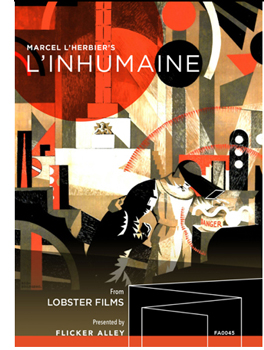 Shortly after, word comes that Norsen’s car has plunged over a cliff into a river. The news makes Lescot realize that she loves him. Grieving, she nevertheless performs at a scheduled concert, after which she is visited by a mysterious man who requests that she act as a witness in identifying Norsen’s newly discovered and mutilated body.
Shortly after, word comes that Norsen’s car has plunged over a cliff into a river. The news makes Lescot realize that she loves him. Grieving, she nevertheless performs at a scheduled concert, after which she is visited by a mysterious man who requests that she act as a witness in identifying Norsen’s newly discovered and mutilated body.
The mysterious man, as is obvious from the start, is Norsen in disguise, preparing an ordeal that will lead Lescot to renounce her cruelty and embrace humanity. (The plot of a man who takes the opportunity afforded by a false report of his death to adopt a new identity apparently fascinated L’Herbier. It would become the core of Feu Mathias Pascal, an adaptation of Luigi Pirandello’s 1904 novel.)
Once Norsen reveals himself to Lescot, he shows her his remarkable laboratory, including a machine that may be able to restore the dead to life.
Lescot’s interest in Norsen has enraged one of her suitors, Djohar de Nopur, and he kills her using a poisonous snake in a bouquet. Norsent rushes her to his laboratory and uses his new invention to revive her.
We learn very little about these characters. They are basically stock figures enacting a familiar melodrama. Georgette Leblance, who plays Lescot, was an opera singer who contributed half of the financing in exchange for playing the role. She employs the florid style associated with the great divas of the 1910s, emoting intensely and striking dramatic poses.
If one embarks upon watching L’Inhumaine as a compelling story, one is likely to be disappointed. Its fascination lies rather in the fact that this simple narrative is considerably embellished with flashy design and the novel depiction of scientific experiment.
A leisurely stroll through some remarkable sets
“Flashy design” here means a great deal. L’Herbier had many prominent friends and contacts within the world of arts and crafts in 1920s Paris. The assemblage of collaborators who worked on the look of L’Inhumaine is quite overwhelming. The heroine’s clothes were by one of the leading fashion designers of the day, Paul Poiret, whose interior design department contributed some of the furniture in her apartment (below). The sculptures in her home are by Joseph Csaky, a Hungarian-born Cubist.
There were four main set designers, with contributions by others. Modernist architect Robert Mallet Stevens created the exteriors of Lescot’s house (left) and Norsen’s (right).
By the way, one can still almost walk into a 1920s film today by visiting the Rue Mallet Stevens in Paris, here seen at the time of its inauguration in 1927.
Other designers included Alberto Cavalcanti, who designed the interiors of Lescot’s mansion, notably the huge dining and entertainment hall at the top of this section and a Caligaresque conservatory.
Perhaps most memorably, painter Fernand Léger planned and built the interior of Norsen’s lab (see bottom). More on this below.
The bare bones of the plot are so simple that L’Herbier can proceed at a remarkably leisurely pace through individual decors. In a period when most films consisted of long strings of short scenes, Claire’s opening banquet for her gentlemen guests lasts a remarkable 45 minutes. This includes cutaways to Einar driving rapidly to her house, dithering about whether he should appear late at the party, and finally, after her callous treatment of him, driving away to his apparent suicide. The second sequence, with Claire deciding to perform her song recital despite her grief over Einar’s death, lasts 25 minutes. The primary action here is simply a near-riot in the theatre between her supporters and those indignant about her part in the causing the young scientist’s death.
The lengthy final section of the film visits the laboratory three times, allowing us to get a good look at one of the great sets of the era.
Cinematic touches
L’Herbier did not entirely depend on his designers to carry the visual interest of the film. He was precocious in his use of wide-angle lenses, a technique that would become more prominent in his 1928 masterpiece, L’Argent. Here the lenses used give a less obvious effect, as in the shots of the jazz band that entertains during the opening banquet (above).
He also achieves some impressive compositions using considerable depth of field, most notably a close-up of the hero’s steering wheel as he tears along a road overlooking a deep valley with a city in the distance. It is here where his supposedly suicide takes place. Another striking shot has the jealous villain in the dark foreground, watching as the disguised Norsen enters Lescot’s dressing room.
Très moderne
Although the combined work of such a group of designers is the film’s primary attraction, L’Inhumaine is also notable as an early example of the science-fiction genre. Norsen’s technical genius is represented as going beyond the technology of the age. We see two instances of what he has invented.
The first marvel of Norsen’s laboratory that he demonstrates to Lescot is a television set (so named in the intertitle). Is this the first reference to television in the cinema? Possibly, though the script in quite an illogical way reverses the technology of how actual television would eventually function. Lescot performs a song into a microphone. Instead of a camera beaming her image out to viewers around the world, a screen in Norsen’s lab shows her images of various listeners reacting in delight to her performance–as if somehow cameras could be placed in every spot where someone, whether Arabs, a young black woman in an African field, or a family group in a tropical setting (below) is listening to her over a radio speaker.
The telephone system in Metropolis (1927) that includes screens upon which the speakers view each other reflects more reasonably what actual inventions were later to follow. One can’t help wonder, however, whether that device was inspired by L’Herbier’s film.
More spectacularly, the giant machines that Norsen uses to restore Lescot to life provide the climax of the film. When Norsen tours Lescot around his lab in an earlier scene, he shows her a huge apparatus, including three large, round components that swing through space like a moving Gabo sculpture (see top). He remarks that he believes the machine could restore a dead person to life, but he has not yet had the opportunity to test it.
Rather than trying to suggest how the machine works, the film keeps the set where Lescot lies dead simple and abstract. In perhaps the most famous image from the film, a ziggurat-shaped platform and some simple diagonal lighting tubes shape the composition, with Norsen nervously peering up to gauge the effectiveness of his invention (see top of this section).
The scene of Lescot’s revival consists of rapid, accelerated editing that had become a major trait of the French Impressionist movement by this time in the wake of La roue and Jean Epstein’s Cœur fidèle. There is no way to convey this remarkable sequence with frames from individual shots; the effect is achieved more by the rhythm of the cutting than by the composition of the individual shots.
The Flicker Alley Blu-ray comes with two alternative musical accompaniments, one by the Alloy Orchestra and an adaptation of the original Darius Milhaud score by Aidje Tafial. We listened to the latter, which worked very well with the film. There is also a helpful booklet of notes.












